
For the love of dog
One woman’s struggle to save her canine companion
November 12, 2022 | Story by Mindy Nissenberg | Photos by Anderson Bobo | Video by Ryan Haley

This article is part of Atrium’s Winter 2022 issue. To view the print edition online, visit our Issuu here.
In the predawn silence of a cold January night, Kim Fowler curled up next to her dog Maddie on her plush bed and gently stroked her short caramel fur. Maddie’s body had become so emaciated that Kim could feel every rib. Maddie’s tail, usually thumping, lay still. Her breathing was raspy and labored.
Is this going to be it? Kim wondered. Is this the night you leave me? Tears dripped down her face and dampened Maddie’s fur.
The steroids the doctors prescribed to treat Maddie’s autoimmune disease were wreaking havoc on her body, eating away at her muscles and sapping away her strength. And because the drugs weakened her immune system, it was that much harder for Maddie’s frail body to fight the pneumonia that had suddenly appeared. Every time a medication helped one problem, it exacerbated another. She just couldn’t win.
And Kim was tired. So very tired.
If Maddie did manage to pull through the night, could Kim? Could she continue to deal with Maddie’s fragile health? Could she continue to juggle Maddie’s strict regimen of medications and meals with three jobs and graduate school on little to no sleep? Could she continue to afford the ever-accumulating vet bills?
She had to. She owed it to Maddie. Kim had made a commitment, and Kim did not take commitment lightly.
Kim mustered up her resolve and determined she would do whatever it took to keep Maddie healthy.
“I promise,” she whispered into Maddie’s ear, “I won’t give up on you.”
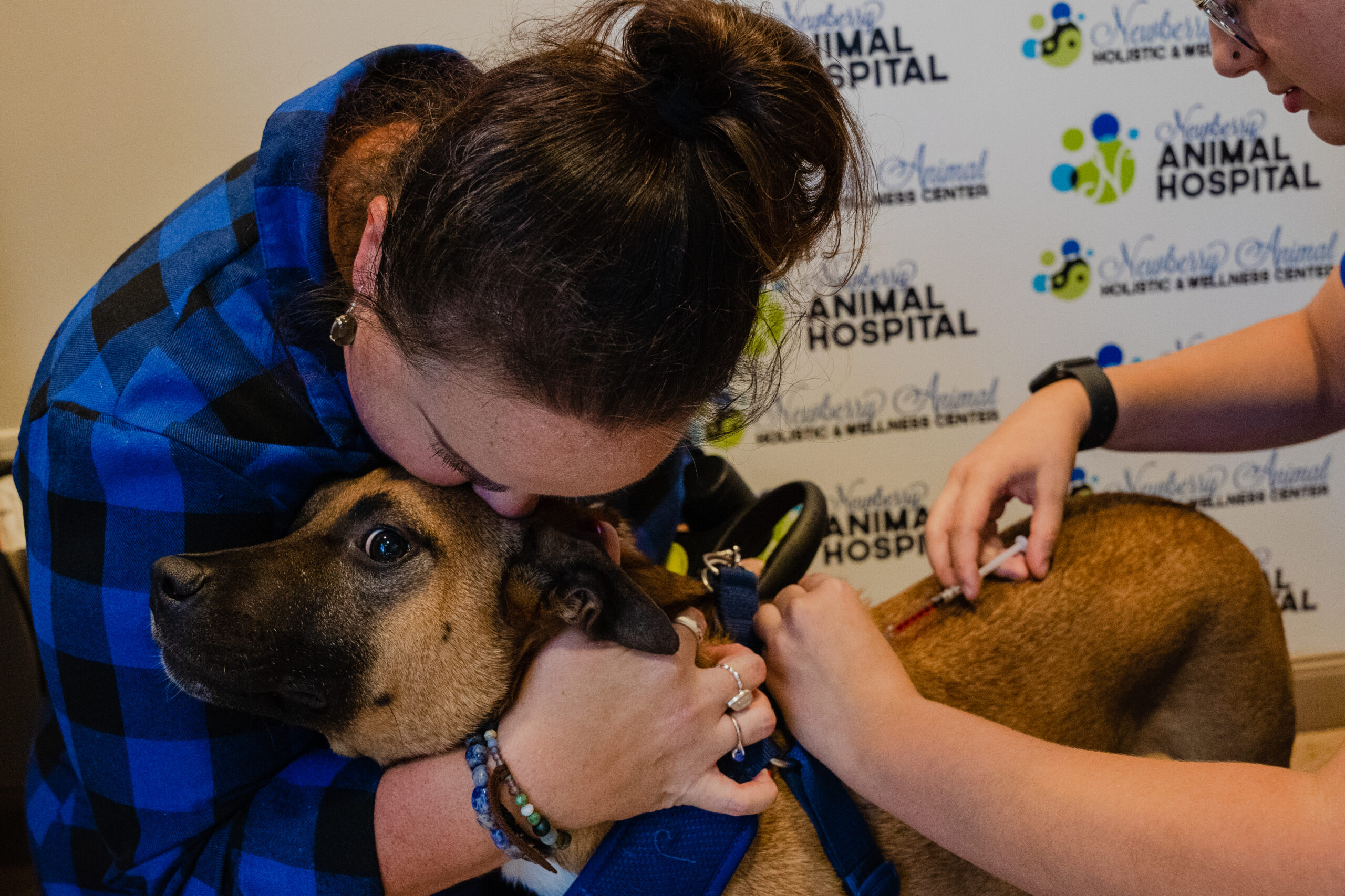
Maddie’s medical condition has meant more trips to the vet than Kim can count. Part of the regimen is a weekly B12 shot.
When Kim met Maddie
Kim has always loved dogs. She grew up with them. But as an adult, her fast-paced career and love of travel made owning a dog impractical. It never seemed to be the right time.
Instead, she became a perpetual auntie to her friends’ dogs, and in that way, she enjoyed the benefits of having a dog from a distance and on her own terms. All the long walks, all the sweet puppy snuggles, all the games of fetch — but none of the responsibility. She was too busy anyway, and she never lived in places that allowed for one.
But deep down, Kim dreamed of having a dog of her own. They’d go on long road trips together, her furry copilot’s head out the window, ears blowing and tongue lolling blissfully in the wind as they barreled down the highway. For so many years, it was just a dream.
When the pandemic hit in March 2020, Kim had time on her hands. She had recently bought a house with a yard in the back. It finally seemed like the perfect time.
She decided to foster.
She found one through Faithful Friends, a Gainesville rescue. All she knew about the dog was that her name was Madeline, she was 2 years old and she had been found wandering the streets.
As Kim arrived to meet the rescue, her ears were pierced by a chorus of howling and barking dogs, including a miniature Rottweiler that barked so viciously Kim was certain it would attack someone. She prayed it wasn’t Madeline.
It wasn’t.
Instead, a volunteer presented her with a medium-sized dog with saggy teats — she had just weaned five puppies. She wasn’t barking. In fact, she wasn’t doing much of anything except shaking nervously, tail tucked.
For weeks after they arrived home, Madeline, now Maddie, was petrified of everything. On walks, she was startled by the slightest sound. Kids on skateboards were the scariest. Any time one passed, she would hide — in a bush, behind a car, anyplace that looked safe.
In the house, she was timid and sought constant refuge in her crate. She didn’t snuggle. She didn’t seem to know how to dog.
Kim didn’t know her backstory, but she thought it likely Maddie had experienced trauma before being rescued. She knew it would take patience and softness to help Maddie come out of her shell. There were lots of treats and soothing pats — when Maddie allowed her to get close enough, that is.
Bit by bit, Maddie decompressed and began to trust Kim. She emerged from her crate and started spending her days lounging at Kim’s feet while she worked. She began sleeping next to Kim’s bed. One day, during a thunderstorm, Maddie jumped on the sofa and slowly scooted next to Kim for their first real cuddle ever.
Aw, man, Kim thought to herself, I’m in big trouble. I can’t let you go now.
A month later, Kim officially adopted Maddie and promised her a forever home. As a “Gotcha Day” present, Kim bought a pet insurance policy.
It’s a good thing she did.
Into the woods
On Memorial Day weekend 2020, Kim’s dream came true. She and Maddie took their first road trip together to the Blue Ridge Mountains.
The breeze blew softly through the leaves of the white oaks, a perfect day for a romp in the woods. A narrow road wound from the house where they were staying, through the trees, down to the main drag. They stepped off the wraparound porch and headed out.
The day of the walk began uneventfully, except for a pile of vomit Kim found on the porch that morning. At least, she thought it was vomit. It looked like a fully formed, undigested, slightly wet breakfast of kibble that had gone down and immediately come back up. She assumed Maddie had eaten something that didn’t agree with her. It was a new place with new smells, after all, and there were so many doggie delicacies to be found in the woods.
At the bottom of the hill, about halfway through their hike, Maddie just plopped down. She did not lie down, a deliberate action. She plopped down, as if her back legs had given out.
Kim tried talking her up. “Come on, you weirdo, let’s go.” But Maddie didn’t budge.
Kim tried lifting her up from beneath her torso to get her back on all four paws. Maddie took a few steps and plopped down again. Kim couldn’t figure out what was going on. Was she tired? Being stubborn? But after a few moments, Maddie was up, trotting home like nothing had happened.
Kim hoped it was a one-off, but it wasn’t.
After they returned home to Gainesville, Maddie’s hind legs kept giving out on her. It happened sporadically, then magically disappeared, just like it had in the mountains. The vomiting continued in the same way. There and then gone.
Kim decided to get Maddie checked out.
The zebra
There is a saying in diagnostic medicine: When you hear hoofbeats, think horses, not zebras. Meaning, before assuming a patient has an oddball malady, check all the common causes first. More often than not, they’re the right ones.
So when Kim brought Maddie in to see Dr. Jessie Stanley, neither of them were really worried. Over the next couple of months, Dr. Stanley addressed everything he thought it could be — a stomach bug, pulled muscles, even kennel cough. But no matter what medications he prescribed, Maddie wasn’t getting any better.
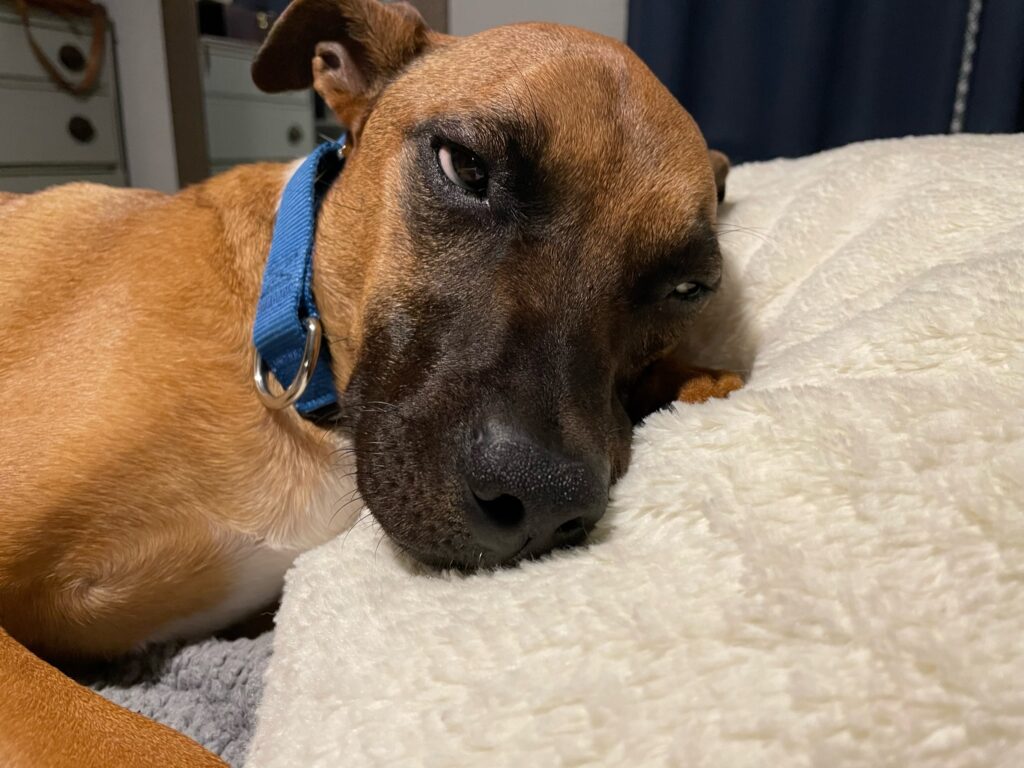
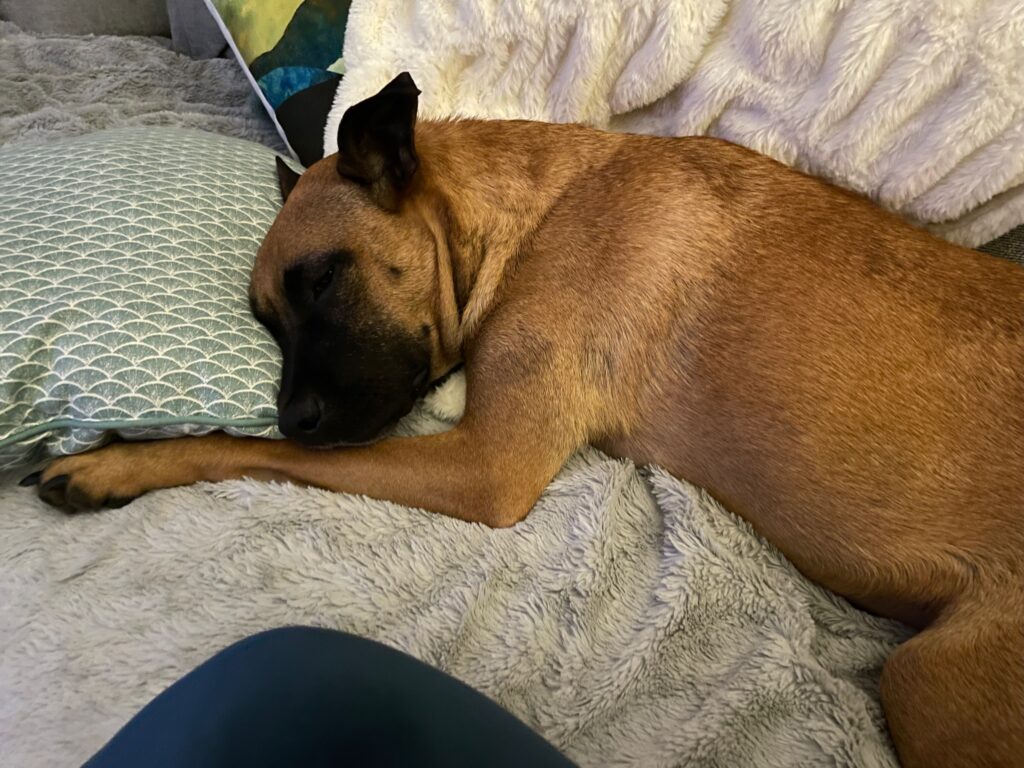
When Maddie was sick, she was listless, plopping down with raspy breaths. Kim wondered if Maddie would make it. (Photos courtesy of Kim Fowler)
In fact, she was getting worse. She wasn’t having as many episodes with her legs, but the vomiting had become nearly constant. After meals. In the middle of the night. On the couch. On the carpet. Kim tried switching foods, elevating her bowl, everything she could think of. Nothing helped.
One day in July, Maddie threw up three times in one hour. Kim took pictures and sent them to Dr. Stanley.
“Something’s wrong,” he said. “Bring her in.”
Three X-rays and one barium swallow later, Dr. Stanley thought he had the answer.
“Have you ever heard of megaesophagus?” he asked Kim.
“Mega what?”
There it was. The zebra.
Megaesophagus, or ME, is just what you think it might be: an enlarged esophagus. The way a normally functioning esophagus moves food from the mouth to the stomach is like an escalator — in humans that is, whose esophagi are vertical. In dogs, whose esophagi are horizontal, it’s more like a moving sidewalk at the airport, propelling travelers from one gate to another.
In dogs with ME, the conveyor belt doesn’t work, and the traveler, or the food, gets stuck, never reaching its destination. Because it has nowhere to go, it comes back up.
The risk of a dog regurgitating everything they eat or drink is twofold. First, if they can’t get food to their stomach, they can die of starvation. Second, as food or water comes back up, it can easily be inhaled into the trachea and down into the lungs. We’ve all experienced this on a small scale at one time or another — when something “goes down the wrong pipe” — but in this case, it’s potentially fatal. This is what Maddie was suffering from on that cold night in January.
Maddie’s diagnosis was serious and required serious attention.
Dr. Stanley, a 10-year veteran of veterinary medicine, is as knowledgeable as they come, but even he recognized his limitations with this condition. He referred Kim and Maddie to specialists, who discovered something else that further complicated the situation — the underlying cause of Maddie’s ME.
Megaesophagus is often secondary to another disease. In Maddie’s case, that disease is an autoimmune disorder called myasthenia gravis, or MG, which causes the body to attack its own neuromuscular junctions — the neurons telling specific muscles to contract — like those signaling an esophagus to swallow or hind legs to move.
It was a double whammy. The specialists gave it to Kim straight: There’s no cure, only management. Every dog responds differently to treatment, but they believed if they could knock out the MG, maybe — just maybe — Maddie would have a fighting chance.
Perhaps out of naïveté of the time, money and energy special needs dogs require or perhaps out of love for Maddie, Kim never for a moment thought she couldn’t tackle the problem head-on. She had read success stories of dogs with this condition making miraculous recoveries. If she could just do everything right, everything the doctors told her to do, Maddie could be one of those success stories, too.
The vets prescribed some drugs with hard-to-pronounce names and told Kim that Maddie needed to eat sitting upright. Remember the moving sidewalk analogy? Imagine flipping the un-moving sidewalk 90 degrees so gravity can do some of the work as the dog eats upright, on its hind legs. They told Kim that Maddie might need to eat like this forever — however long “forever” turned out to be.
Kim had seen pictures of Bailey Chairs, special feeding chairs for dogs with ME that facilitate this. She thought she could build one herself. She enlisted the help of her mom and got to work.
Building a Bailey Chair
Cathy Yoder’s home in Tampa has a three-car garage, but there’s only room for two cars. She transformed the third space into her workshop.
“She’s like Bob Vila,” Kim teases her with a wink. She’s clearly in awe of her mom’s talents and massive array of tools.
Together, they took precise measurements of Maddie — as precise as they could get of the squirmy 42-pound dog — and carefully cut the plywood with a table saw. After they pieced it together and applied all the hardware, adding vinyl-upholstered padding for comfort and brass tacks for elegance (only the best for Maddie!), they stood back and admired their handiwork.
At first, Maddie was wary of the Bailey Chair, and Kim had to physically put her in it. But Maddie quickly became a pro. In a maneuver reminiscent of a truck completing a three-point turn in reverse, Maddie backs herself into the chair at mealtime, settles on her haunches and props her paws on the ledge to sit fully upright as she eats.
Maddie’s mealtime is not that of a normal dog’s. She has to sit in a specialized chair that uses gravity to move food down to her stomach.
Kim was optimistic that eating upright, combined with the medications the vets had prescribed, would stop Maddie’s regurgitation. And for a while, it did. And then it didn’t.
Maybe it was what she was feeding her. Kim began experimenting, first softening the kibble with warm water. When that didn’t work, she tried half kibble and half canned. Then all canned. Then meatballs.
Maybe it was how Kim was feeding Maddie. Instead of giving her food in a bowl on the ledge of the chair, Kim started feeding her with a spoon.
Maybe it was how long she sat upright after eating. She went from 10 minutes to 15 to 20, all the way up to half an hour of sitting upright after every meal.
Maybe it was the medication. The doctors tried increasing the dosage, decreasing the dosage, adding new meds to help Maddie’s body absorb the other meds. They tried different drugs altogether.
Sometimes, there was a glimmer of improvement — Maddie even went into remission once — but inevitable decline always followed.
That’s when the aspiration pneumonia set in. And that long night of not knowing what would happen next. Of wondering if Maddie would make it. Of thinking about the promise Kim made to take care of her, whatever it took. But she didn’t know what else to do.
Upright Canine Brigade to the rescue
Looking for guidance, Kim turned to a Facebook group called the Upright Canine Brigade, a community of people who have dogs with megaesophagus.
It was overwhelming at first. So much information. So many medications with long, complicated names. So many stories.
For all the hopeful stories posted on the group’s page, stories of recovery and beating the odds, there were as many stories of heartbreak, of not making it: “the meds aren’t working” and “this crept up on us so fast” and “we’ve tried everything” and “our Buddy crossed the rainbow bridge last night” kinds of stories. Pups like Maddie who couldn’t catch a break. People like Kim who were at the end of their rope.
But it was comforting to know there were other people who had been there, who knew how hard it could be to take care of a dog with ME. They crowdsourced their collective wisdom and shared it freely. They offered prayers and support and listening ears for anyone who just needed to vent.
Slowly, Kim began to see posts that were helpful, and she started asking her own questions.
Kim learned so much from the Upright Canine Brigade. It was where she learned how using slippery elm to coat the esophagus can reduce irritation and help the food slide down. It was where she learned certain medications are more effective when frozen, or in liquid form or spaced strategically throughout the day. It was where she learned different foods to try and how to achieve the right texture. It was where Kim first heard that research on a drug called Sildenafil, the generic name for Viagra (yes, that Viagra) was showing incredible promise in dogs with ME.
Kim brought all this knowledge back to the veterinarians. Fortunately, they were willing to listen.
The magic bullet
Plink. Plink. Plink.
Every Sunday, Kim fills a pill box that would put anyone’s grandma’s to shame. The multicolored box contains four rows for each day: morning, noon, evening and bedtime. Kim fills every last one. She twists open pharmacy bottles, slices open blister packs and meticulously divvies up all the medications for the week, including Maddie’s twice-daily dose of Viagra.
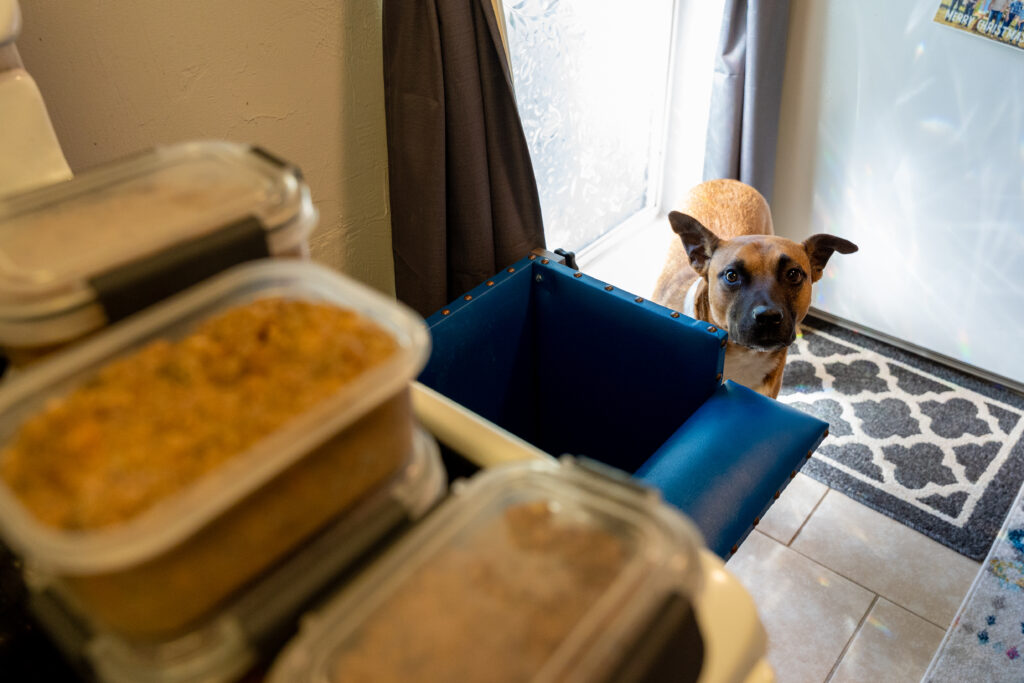
Maddie’s food is no basic kibble. Kim makes her meals by hand.
Adding Viagra to Maddie’s drug cocktail had an immediate effect. Almost overnight, her regurgitation abated, her energy returned and she began to “dog” again after a year and a half of being too sick to enjoy life.
And all the trial and error inspired by the Upright Canine Brigade? It helped Kim devise a system of care that keeps Maddie stable. It includes meals and medications spaced out every two hours, beginning at 9 a.m. and ending, sometimes, at midnight; weekly B12 shots at the vet and special dog food that Kim makes in her Instant Pot. She combines canned food with ground turkey, bone broth, carrots and sweet potatoes, all thickened with gelatin to achieve the optimal texture to slide down Maddie’s gullet. Kim batch-cooks six days’ worth at a time. Sometimes her fridge contains as much food for Maddie as it does for herself.
The cost
All of this has worked wonders for Maddie. But at what cost to Kim?
Maddie’s care has not come cheaply. Over the past two years, her medical bills have totaled more than $20,000. By luck, fate or her mother’s sage advice, Kim had the foresight to purchase pet insurance before Maddie got sick. So, instead of paying the full amount, her out-of-pocket expenses, including pet insurance premiums, have been just shy of half that. It’s better than it could have been. Kim knows she’s fortunate to have the resources and can’t imagine how she’d have managed otherwise. But it’s still a painful amount, more than three times what the average pet owner spends on pet care. It has all but wiped out her savings.
But as difficult as the financial hit has been, the emotional toll is worse. There have been so many times, like the night in January, when Kim has broken down. Over the fear of the unknown trajectory of Maddie’s illness. Feelings of failure for not being able to fix it. The stress of trying to conduct Zoom meetings while Maddie regurgitates beside her. The worry that she will always need to work remotely because how on earth could she work outside the home when Maddie needs round-the-clock care? She mourns the spontaneity she enjoyed before Maddie, when she could meet friends for drinks or take a weekend trip at a moment’s notice. Her carefree life is but a memory.
Is it too much?
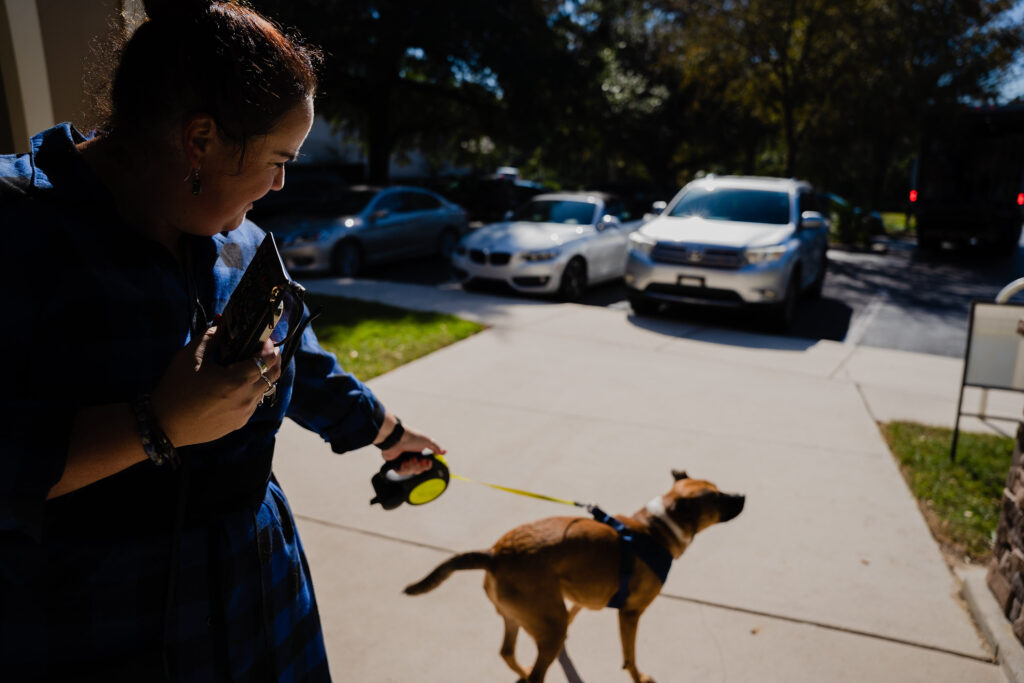
Once, Maddie was too sick to even move. Now, she bounds at the end of her leash with ceaseless energy.
It’s been a difficult journey. Yet to Kim, the sacrifices are worth it. She has a bond with Maddie. Maddie feeds her soul. Kim is hesitant to say she loves her like a child — she gets that it’s different — but she does. She loves her.
Not everyone in Kim’s life understands the choices she has made to put Maddie’s needs first at the expense of her own, to sink all of that time and energy and money and emotional currency into a dog.
Her mom, Cathy, gets it. She believes you do what you need to for a pet, no matter what, and perhaps there’s a reason Maddie came into Kim’s life.
“Maybe somebody upstairs realized that this dog needed somebody, and Kim needed her,” she said.
Kim’s best friend, Christine, agrees that Kim is the best thing that could have happened to Maddie. But she questions whether Maddie is the best thing that could have happened to Kim. She knows Maddie makes her happy, but the day-to-day demands are just so intense, and she hates that Kim carries that burden. She hates that it has robbed Kim of her freedom.
But the alternatives are unthinkable.
Out of the woods?
Kim likes to imagine how Maddie will look as an old lady, her black muzzle gray with age. She looks forward to that. But she’s a realist. She knows death is a part of life, and sometimes, ending a dog’s life is the kindest thing you can do for them.
Kim often thinks about quality of life.
Maddie seems to be living a great life at the moment. She is a healthy chunk of a dog who runs zoomies in the backyard and plays endlessly with the collection of technicolor toys Kim has bought for her. Seeing her now, you’d never guess how close she came to death and everything it took to bring her back from the brink. She is a lucky dog.
But Kim knows this could be borrowed time. She has experienced enough with Maddie that she has seen how dire things can become without any warning.
She figures she will know when it’s time to say goodbye.
“I’ve thought about this. I guess people say they’ll tell you. So, I don’t know,” Kim says. “I think she’ll tell me. But it better not be anytime soon.”

Maddie is now 4 years old and, for the time being, leading a good life.
Mindy Nissenberg met Kim Fowler in 2019 when they were classmates in a master’s program at the University of Florida. Mindy followed parts of Maddie and Kim’s journey as events unfolded. She knew it was a story she wanted to tell.